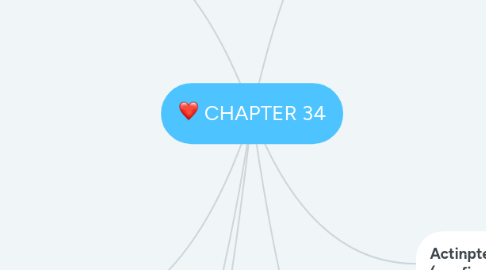
1. Chondricthyes
1.1. Sharks
1.1.1. suspension feeders but most are carnivores
1.1.2. short digestive tract with ridge called the spiral valve to increase digestive surface area
1.1.3. acute senses: sight, smell, ability yo detect electrical fields
1.1.4. Eggs fertilized internally, but embryos can develop in many ways
1.1.4.1. Oviparous: eggs hatch outside of mothers body
1.1.4.2. Ovoviviparous: Embryo develops within the uterus and nourished by egg yolk
1.1.4.3. Viviparous: Embryo develops within the uterus and is nourished through a yolk sac placenta from mothers blood
1.1.5. reproductive tract, excretory system, and digestive tract empty into a common CLOACA
1.2. Rays
1.3. Skates
1.4. Have a skeleton composed of primarily cartilage
1.4.1. subclass: ratfishes or chimaeras
2. Myxini (hagfish)
2.1. Lacked jaws, one of the 2 lineages today, hagfish and lampreys who are jawless vertebrates.
2.1.1. Lack a backbone
2.1.2. Rudimentary Vertibrae and Phylogenetic analysis indicate that both are vertebrates
2.1.3. CLADE: CYCLOSTOMES
2.2. TRAITS
2.2.1. reduced vertebrae
2.2.2. Flexible rod of cartilage derived from notochord
2.2.3. Small brain, eyes, ears, and toothlike formations
2.2.4. Cartilaginous skull
2.3. Marine, most are bottom dwelling scavengers
3. Urcochordata (Tunicates)
3.1. More related to chordates than lancelets
3.1.1. Resemble chordates during larval stage
3.2. draws water through incurrent siphon, filters food product
3.3. have less HOX genes than other vertebrates
4. Lancelets (Cephalochordata)
4.1. Blade Shaped
4.1.1. Marine Suspension feeders
4.1.2. CHARACTERISTICS : CIRRI, MOUTH, ATRIUM, DIGESTIVE TRACT, ATRIOPORE, SEGMENTAL MUSCLES, ANUS
4.2. HOX genes that organize vertebrate brain are expressed in the lancelets simple nerve cord tip.
4.2.1. Genes associated with heart and thyroid are common to chordates
4.2.1.1. genes associated with transmission of nerve impulses are unique to vertebrates
5. Amniotes
5.1. Group of tetrapods whose living members are the reptiles, including birds, and mammals
5.1.1. Amniotic eggs: Amniotic cavity with amniotic fluid, Embryo, Shell, Yolk, Albumen, Amnion, Yolk sac, Chorion, Allantois
5.1.1.1. key to adaption of life on land
5.1.1.2. amniotic eggs of most reptiles and some mammals have a shell
5.1.2. Impermeable skin
5.1.3. ability to use ribcage to ventilate the lungs
5.2. REPTILES:
5.2.1. have scales, create water proof barrier
5.2.2. lay shelled eggs on land
5.2.3. ectothermic: absorb external heat as main source of body hear
5.2.3.1. regulate body temp through behavioral adaptions
5.3. TURTLES:
5.3.1. boxlike shell made of upper and lower shields fused to the vertebrae, clavicle, ad ribs.
5.3.2. Live in deserts, ponds, rivers, seas
5.3.2.1. largest species live in the sea
5.4. Lepidosaurs
5.4.1. squamates
5.4.1.1. lizards and snakes
5.4.1.1.1. snakes
5.4.1.2. most numerous and diverse reptiles apart from birds
6. Actinpterygii (ray fins)
6.1. CLADE OF GNATHOSTOMES: OSTEICHTHYES
6.1.1. Bony endoskeletons
6.1.2. Bony fishes and Tetrapods
6.2. include nearly all familiar aquatic osteichthyans
6.2.1. fins are supported mainly by flexible rays, modified for maneuvering, defense and other functions
6.2.2. control buoyancy with air sac called swim bladder
6.2.3. breathe by drawing water over gills protected by operculum
6.2.4. lateral line system
6.2.5. most are oviparous, but some have internal fertilization and birthing
7. Monotremes
7.1. small group of egg laying mammals
7.1.1. echidnas
7.1.2. platypus

